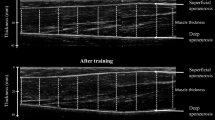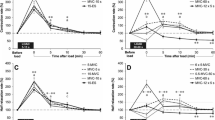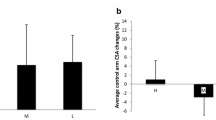Abstract
Purpose
The acute effects of a single training session on muscle activity and oxygenation were compared between a new strength training method (3/7 protocol) and a more classical method (4 × 6 and 8 × 6 protocols).
Method
All protocols consisted of lifting and lowering a load (70 % 1RM) with the elbow-flexor muscles. The 3/7 protocol involved 5 sets of increasing number of repetitions during successive sets (from 3 to 7 repetitions), and brief rest interval between sets (15 s). The other two protocols consisted of either 4 or 8 sets of 6 repetitions with a rest interval between sets of 2.5 min. Surface electromyogram (EMG) of biceps brachii, brachioradialis, and triceps brachii, and tissue oxygenation index (TOI) of the two elbow flexors were recorded.
Result
For all muscles, EMG increased similarly (50–60 %) during each set in the 4 × 6 and 8 × 6 protocols but gradually during the successive sets in the 3/7 protocol. At protocol completion, EMG reached greater value (p < 0.003) in the 3/7 protocol. TOI decreased during each set in all protocols but contrary to 4 × 6 and 8 × 6 protocols, it did not return to resting values between sets in the 3/7 protocol. The deficit in TOI per repetition was greater (p < 0.001) in the 3/7 (−142.5 ± 48.8 %) than 4 × 6 (−113.1 ± 48.8 %) and 8 × 6 (−105.9 ± 59.2 %) protocols for biceps brachii but not brachioradialis.
Conclusion
The results indicate that brief rest interval between sets and incremental number of repetitions in successive sets induced greater muscle activity and metabolic changes compared with method of constant repetitions per set and longer rest interval.




Similar content being viewed by others
Abbreviations
- 1RM:
-
One repetition maximum
- EMG:
-
Electromyography
- TOI:
-
Tissue oxygenation index
- NIRS:
-
Near-infrared spectroscopy
- MVC:
-
Maximal voluntary contraction
- nTHI:
-
Normalised index of total haemoglobin
- ANOVA:
-
Analysis of variance
- aEMG:
-
Average electromyogram
- ATP:
-
Adenosine triphosphate
- PCr:
-
Phosphoryl creatine
- Pi:
-
Inorganic phosphate
- ADP:
-
Adenosine diphosphate
- AMP:
-
Adenosine monophosphate
References
Aagaard P (2003) Training-induced changes in neural function. Exerc Sport Sci Rev 31:61–67
Aagaard P, Andersen JL, Dyhre-Poulsen P, Leffers AM, Wagner A, Magnusson SP, Halkjaer-Kristensen J, Simonsen EB (2001) A mechanism for increased contractile strength of human pennate muscle in response to strength training: change in muscle architecture. J Physiol 534:613–623
Ahtiainen JP, Pakarinen A, Alen M, Kraemer WJ, Häkkinen K (2005) Short vs. long rest period between the sets in hypertrophic resistance training: influence on muscle strength, size, and hormonal adaptations in trained men. J Strength Cond Res 19:572–582
Barry BK, Riley ZA, Pascoe MA, Enoka RM (2008) A spinal pathway between synergists can modulate activity in human elbow flexor muscles. Exp Brain Res 190:347–359
Baudry S, Sarrazin S, Duchateau J (2013) Effects of load magnitude on muscular activity and tissue oxygenation during repeated elbow flexions until failure. Eur J Appl Physiol 113:1895–1904
Bruusgaard JC, Johansen IB, Egner IM, Rana ZA, Gundersen K (2010) Myonuclei acquired by overload exercise precede hypertrophy and are not lost on detraining. Proc Natl Acad Sci 107:15111–15116
Burd NA, Holwerda AM, Selby KC, West DW, Staples AW, Cain NE, Cashaback JG, Potvin JR, Baker SK, Phillips SM (2010) Resistance exercise volume affects myofibrillar protein synthesis and anabolic signalling molecule phosphorylation in young men. J Physiol 588:3119–3130
Campos GE, Luecke TJ, Wendeln HK, Toma K, Hagerman FC, Murray TF, Ragg KE, Ratamess NA, Kraemer WJ, Staron RS (2002) Muscular adaptations in response to three different resistance-training regimens: specificity of repetition maximum training zones. Eur J Appl Physiol 88:50–60
Carpentier A, Duchateau J, Hainaut K (2001) Motor unit behaviour and contractile changes during fatigue in the human first dorsal interosseus. J Physiol 534:903–912
de Salles BF, Simão R, Miranda F, Novaes S, Lemos A, Willardson JM (2009) Rest interval between sets in strength training. Sports Med 39:765–777
Delp MD, Laughlin MH (1998) Regulation of skeletal muscle perfusion during exercise. Acta Physiol Scand 162:411–419
Dideriksen JL, Enoka RM, Farina D (2011) Neuromuscular adjustments that constrain submaximal EMG amplitude at task failure of sustained isometric contractions. J Appl Physiol 111:485–494
Duchateau J, Baudry S (2011) Training adaptation of the neuromuscular system. In: Komi PV (ed) Neuromuscular aspects of sport performance. Wiley, Oxford, pp 216–253
Duchateau J, Semmler JG, Enoka RM (2006) Training adaptations in the behavior of human motor units. J Appl Physiol 101:1766–1775
Felici F, Quaresima V, Fattorini L, Sbriccoli P, Filligoi GC, Ferrari M (2009) Biceps brachii myoelectric and oxygenation changes during static and sinusoidal isometric exercises. J Electromyogr Kinesiol 19:1–11
Ferrari M, Mottola L, Quaresima V (2004) Principles, techniques, and limitations of near infrared spectroscopy. Can J Appl Physiol 29:463–487
Grassi B, Rossiter HB, Zoladz JA (2015) Skeletal muscle fatigue and decreased efficiency: two sides of the same coin? Exerc Sport Sci Rev 43:75–83
Harris RC, Edwards RH, Hultman E, Nordesjö LO, Nylind B, Sahlin K (1976) The time course of phosphorylcreatine resynthesis during recovery of the quadriceps muscle in man. Pflugers Arch 367:137–142
Henselmans M, Schoenfeld BJ (2014) The effect of inter-set rest intervals on resistance exercise-induced muscle hypertrophy. Sports Med 44:1635–1643
Kadi F, Schjerling P, Andersen LL, Charifi N, Madsen JL, Christensen LR, Andersen JL (2004) The effects of heavy resistance training and detraining on satellite cells in human skeletal muscles. J Physiol 558:1005–1012
Keenan KG, Farina D, Maluf KS, Merletti R, Enoka RM (2005) Influence of amplitude cancellation on the simulated surface electromyogram. J Appl Physiol 98:120–131
Kraemer WJ, Ratamess NA (2005) Hormonal responses and adaptations to resistance exercise and training. Sports Med 35:339–361
Kraemer WJ, Noble BJ, Clark MJ, Culver BW (1987) Physiologic responses to heavy-resistance exercise with very short rest periods. Int J Sports Med 8:247–252
Kraemer WJ, Marchitelli L, Gordon SE, Harman E, Dziados JE, Mello R, Frykman P, McCurry D, Fleck SJ (1990) Hormonal and growth factor responses to heavy resistance exercise protocols. J Appl Physiol 69:1442–1450
Kvorning T, Andersen M, Brixen K, Schjerling P, Suetta C, Madsen K (2007) Suppression of testosterone does not blunt mRNA expression of myoD, myogenin, IGF, myostatin or androgen receptor post strength training in humans. J Physiol 578:579–593
Laurent C, Penzer F, Letroye B, Carpentier A, Baudry S, Duchateau J (2016) Effect of a strength training method characterized by an incremental number of repetitions across sets and a very short rest interval. Sci Sports. doi:10.1016/j.scispo.2016.04.004
Legeard E (2005) Force: entraînement et musculation, de la théorie à la pratique. Amphora, Paris
Lévénez M, Kotzamanidis C, Carpentier A, Duchateau J (2005) Spinal reflexes and coactivation of ankle muscles during a submaximal fatiguing contraction. J Appl Physiol 99:1182–1188
Manini TM, Clark BC (2009) Blood flow restricted exercise and skeletal muscle health. Exerc Sport Sci Rev 37:78–85
McMahon S, Jenkins D (2002) Factors affecting the rate of phosphocreatine resynthesis following intense exercise. Sports Med 32:761–784
Moritani T (1993) Neuromuscular adaptations during the acquisition of muscle strength, power and motor tasks. J Biomech 26:95–107
Place N, Yamada T, Bruton JD, Westerblad H (2010) Muscle fatigue: from observations in humans to underlying mechanisms studied in intact single muscle fibres. Eur J Appl Physiol 110:1–15
Ratamess NA, Falvo MJ, Mangine GT, Hoffman JR, Faigenbaum AD, Kang J (2007) The effect of rest interval length on metabolic responses to the bench press exercise. Eur J Appl Physiol 100:1–17
Rooney KJ, Herbert RD, Balnave RJ (1994) Fatigue contributes to the strength training stimulus. Med Sci Sports Exerc 26:1160–1164
Sahlin K, Harris RC, Hultman E (1979) Resynthesis of creatine phosphate in human muscle after exercise in relation to intramuscular pH and availability of oxygen. Scand J Clin Lab Invest 39:551–558
Sale DG (1988) Neural adaptation to resistance training. Med Sci Sports Exerc 20:S135–S145
Schott J, McCully K, Rutherford OM (1995) The role of metabolites in strength training. II Short versus long isometric contractions. Eur J Appl Physiol Occup Physiol 71:337–341
Snyder AC, Parmenter MA (2009) Using near-infrared spectroscopy to determine maximal steady state exercise intensity. J Strength Cond Res 23:1833–1840
Staron RS, Karapondo DL, Kraemer WJ, Fry AC, Gordon SE, Falkel JE, Hagerman FC, Hikida RS (1994) Skeletal muscle adaptations during early phase of heavy-resistance training in men and women. J Appl Physiol 76:1247–1255
Tillin NA, Folland JP (2014) Maximal and explosive strength training elicit distinct neuromuscular adaptations, specific to the training stimulus. Eur J Appl Physiol 114:365–374
Vedsted P, Blangsted AK, Søgaard K, Orizio C, Sjøgaard G (2006) Muscle tissue oxygenation, pressure, electrical, and mechanical responses during dynamic and static voluntary contractions. Eur J Appl Physiol 96:165–177
Vingren JL, Kraemer WJ, Ratamess NA, Anderson JM, Volek JS, Maresh CM (2010) Testosterone physiology in resistance exercise and training: the up-stream regulatory elements. Sports Med 40:1037–1053
Wernbom M, Augustsson J, Raastad T (2008) Ischemic strength training: a low-load alternative to heavy resistance exercise? Scand J Med Sci Sports 18:401–416
West DW, Burd NA, Tang JE, Moore DR, Staples AW, Holwerda AM, Baker SK, Phillips SM (2010) Elevations in ostensibly anabolic hormones with resistance exercise enhance neither training-induced muscle hypertrophy nor strength of the elbow flexors. J Appl Physiol 108:60–67
Acknowledgments
Félix Penzer is financially supported by a grant of the Sport Ministry of Wallonia-Brussels Federation of Belgium (Centre d’Aide à la Performance Sportive).
Author information
Authors and Affiliations
Corresponding author
Ethics declarations
Conflict of interest
The authors declare that they have no conflict of interest.
Additional information
Communicated by Olivier Seynnes.
Rights and permissions
About this article
Cite this article
Penzer, F., Cabrol, A., Baudry, S. et al. Comparison of muscle activity and tissue oxygenation during strength training protocols that differ by their organisation, rest interval between sets, and volume. Eur J Appl Physiol 116, 1795–1806 (2016). https://doi.org/10.1007/s00421-016-3433-8
Received:
Accepted:
Published:
Issue Date:
DOI: https://doi.org/10.1007/s00421-016-3433-8




